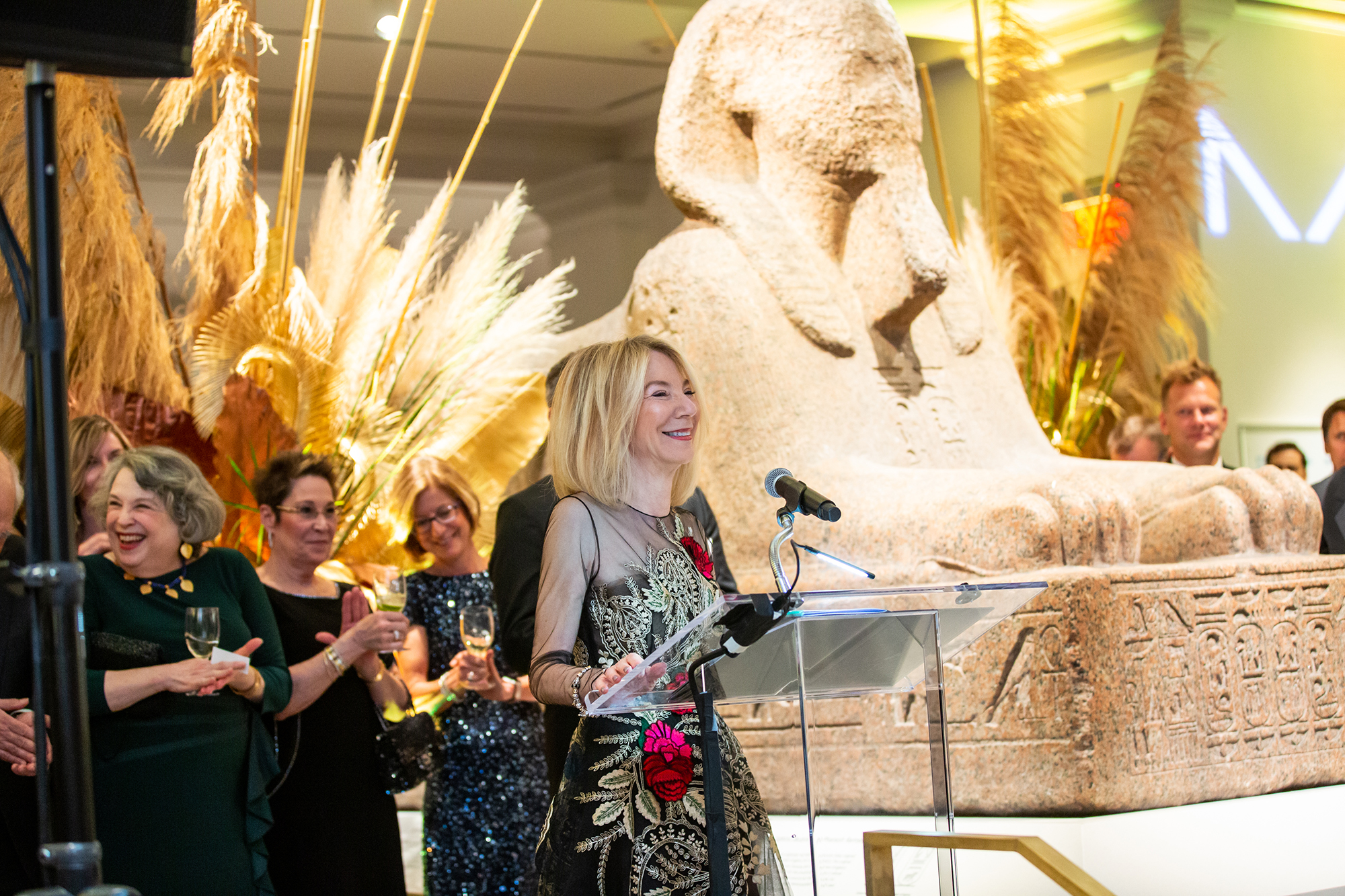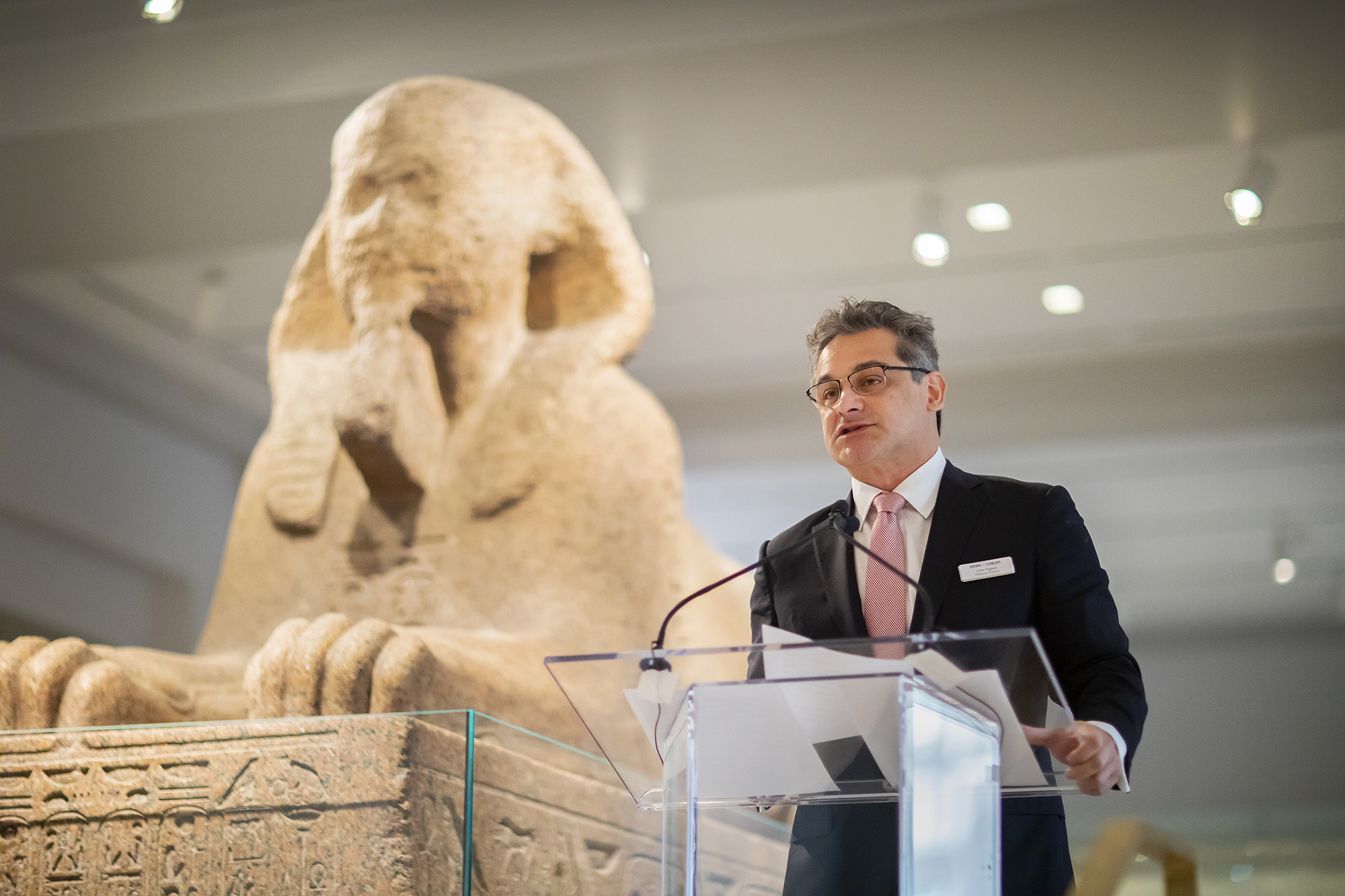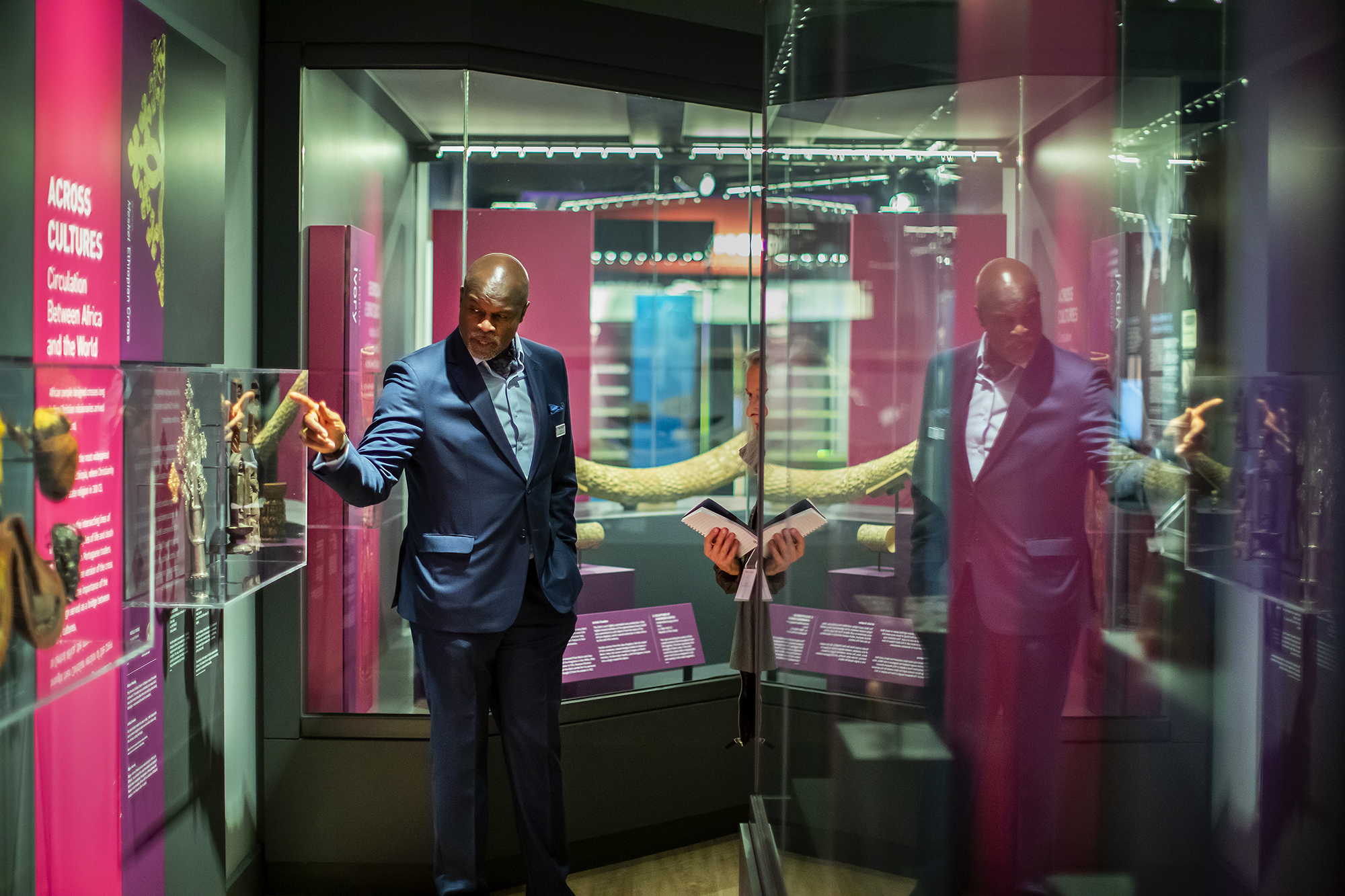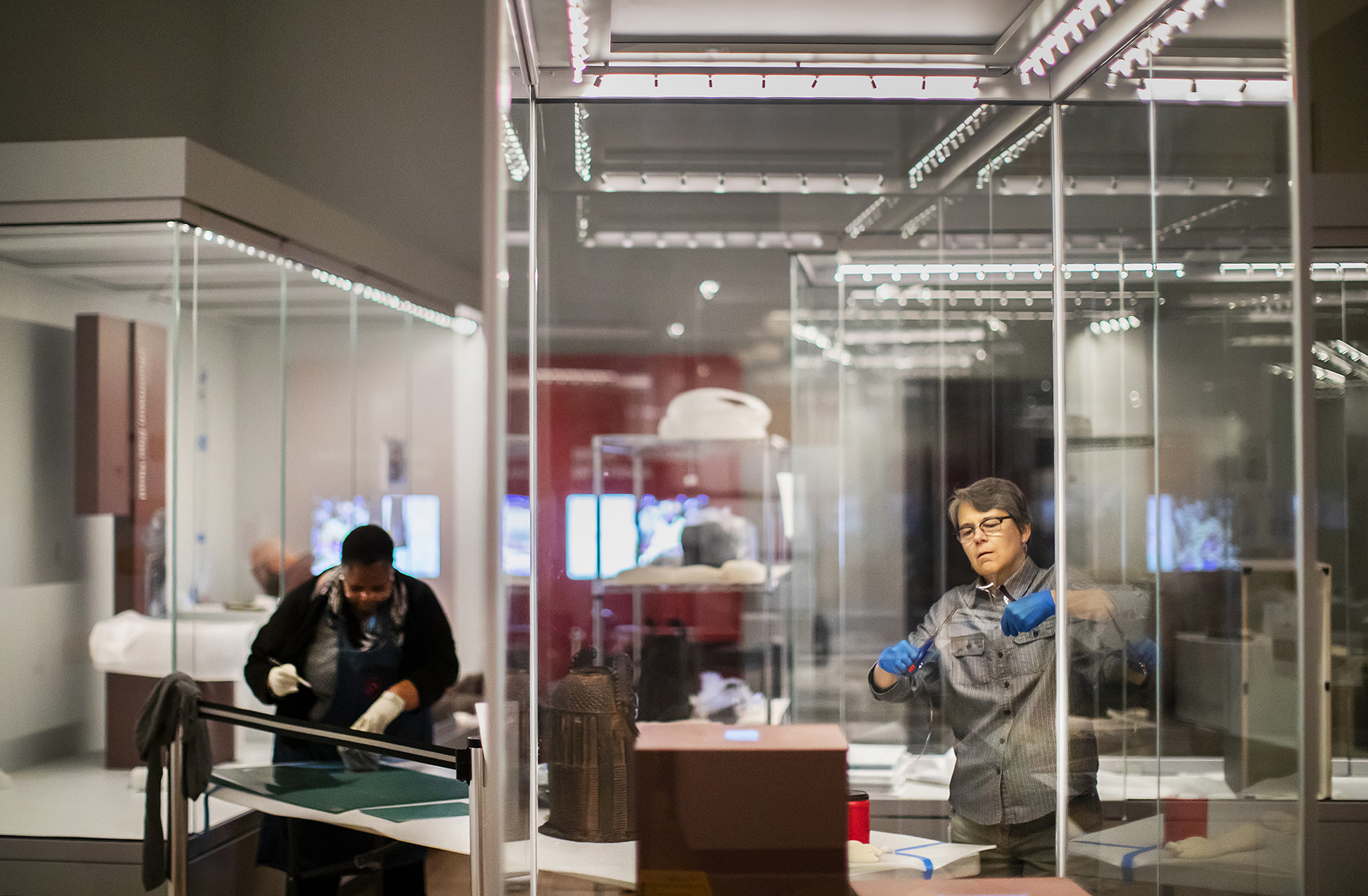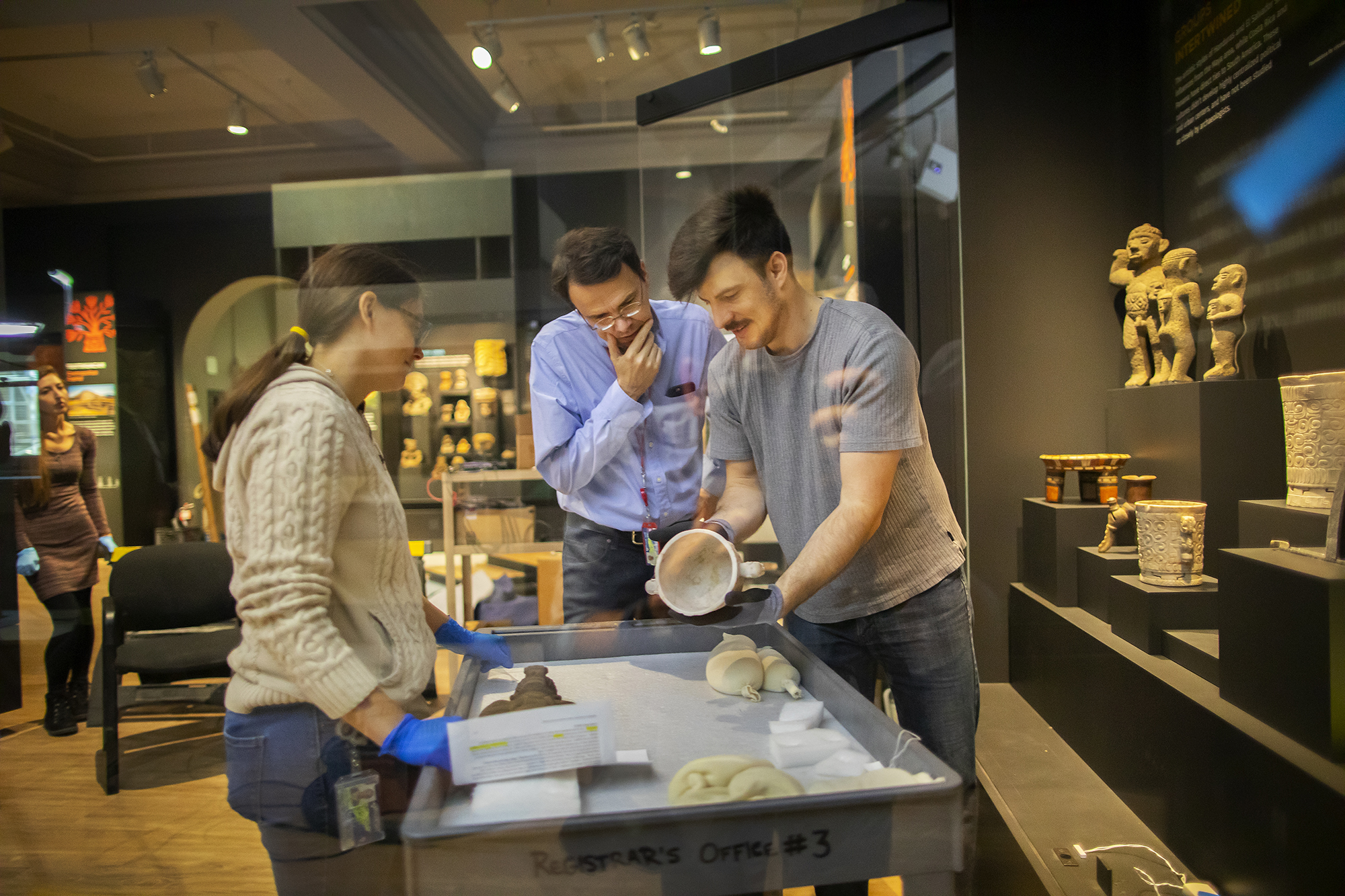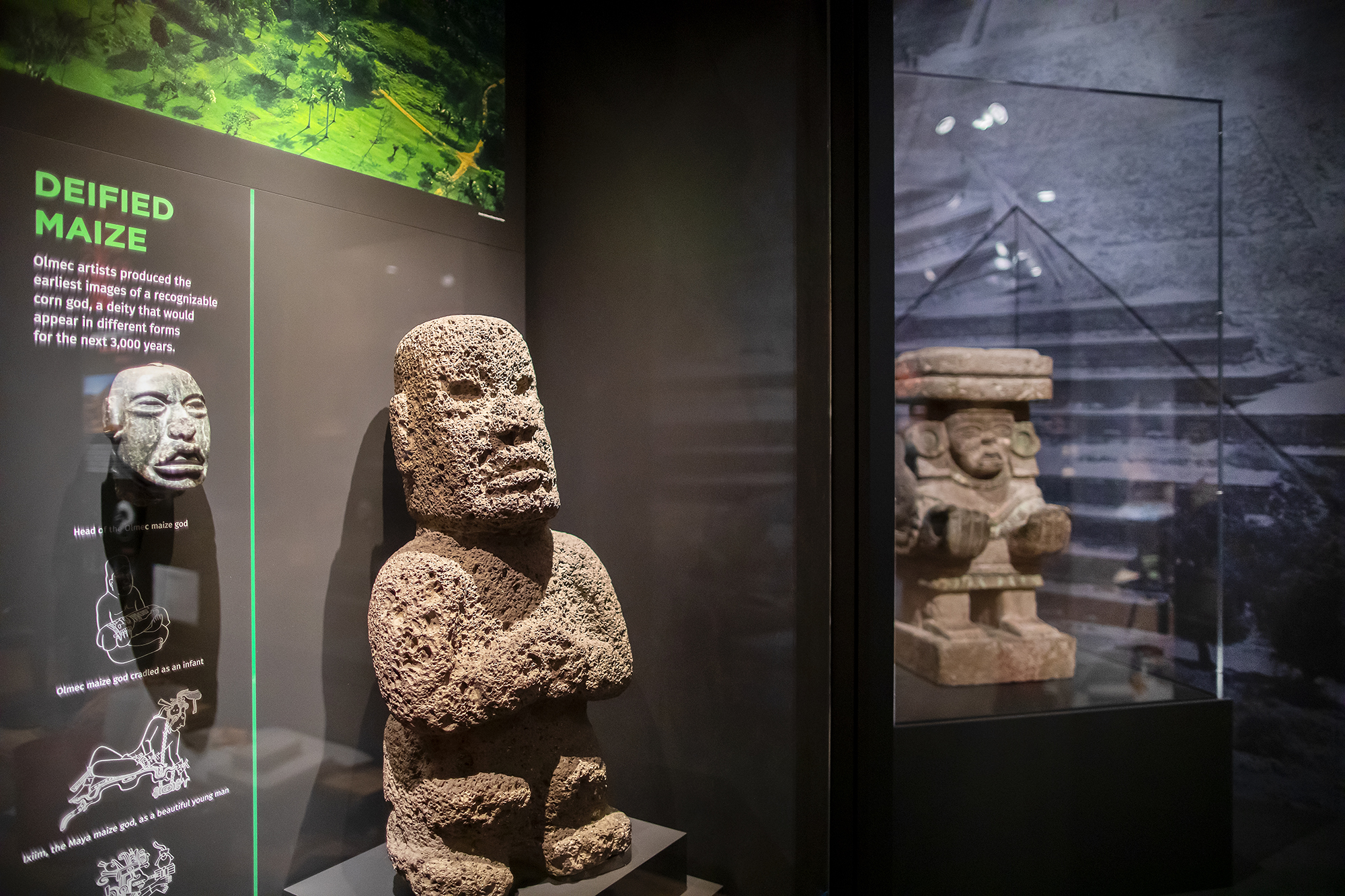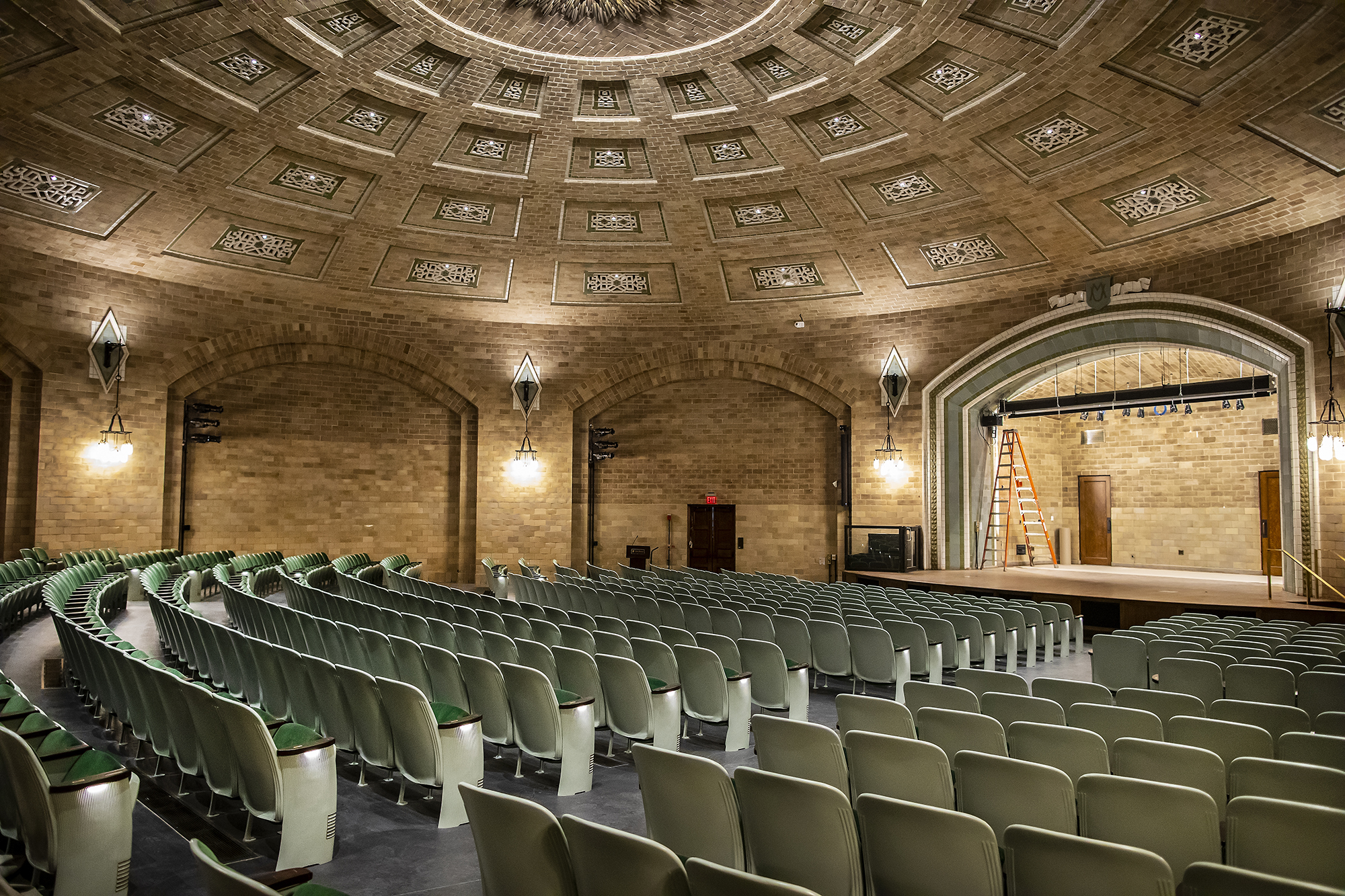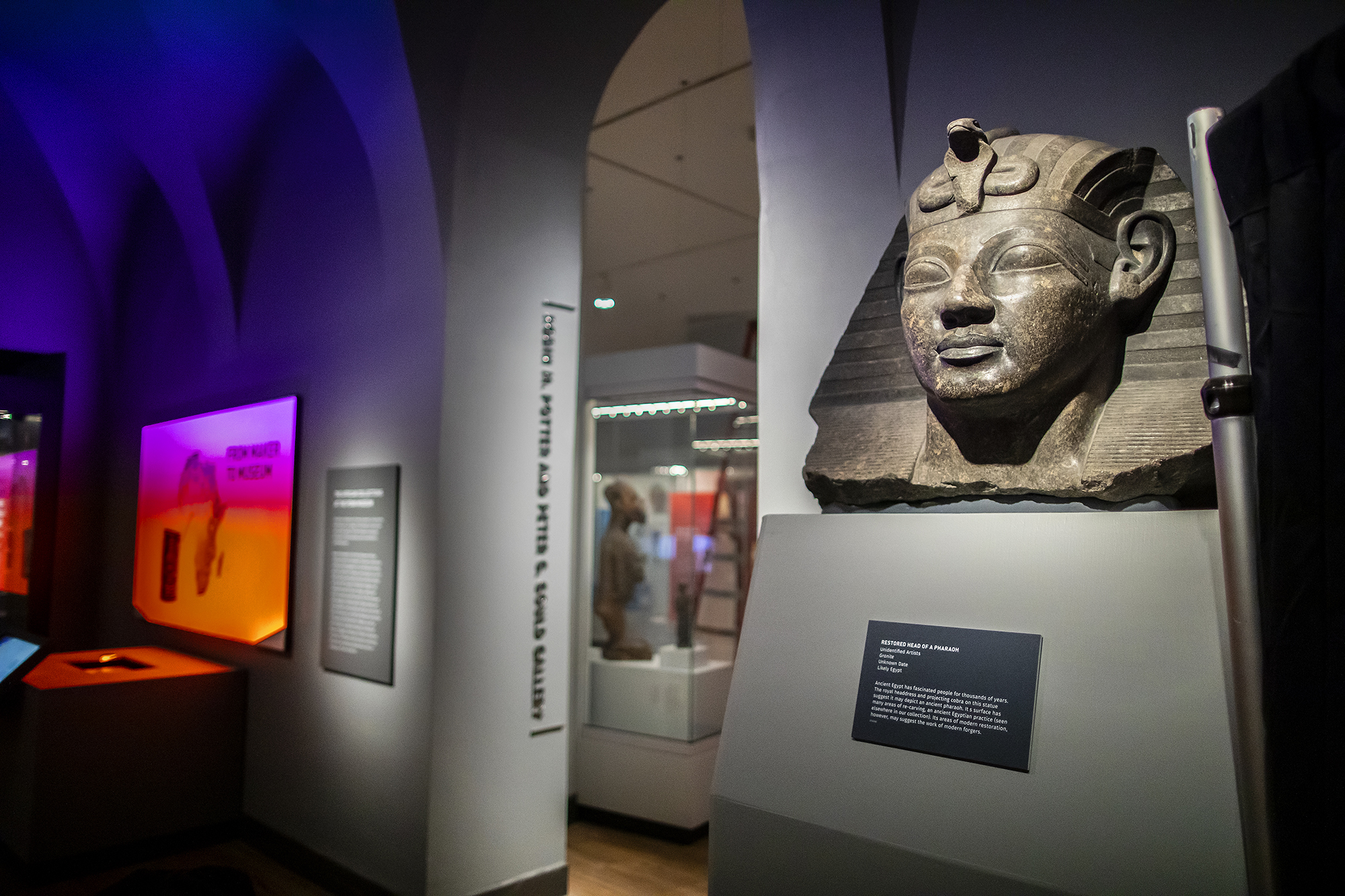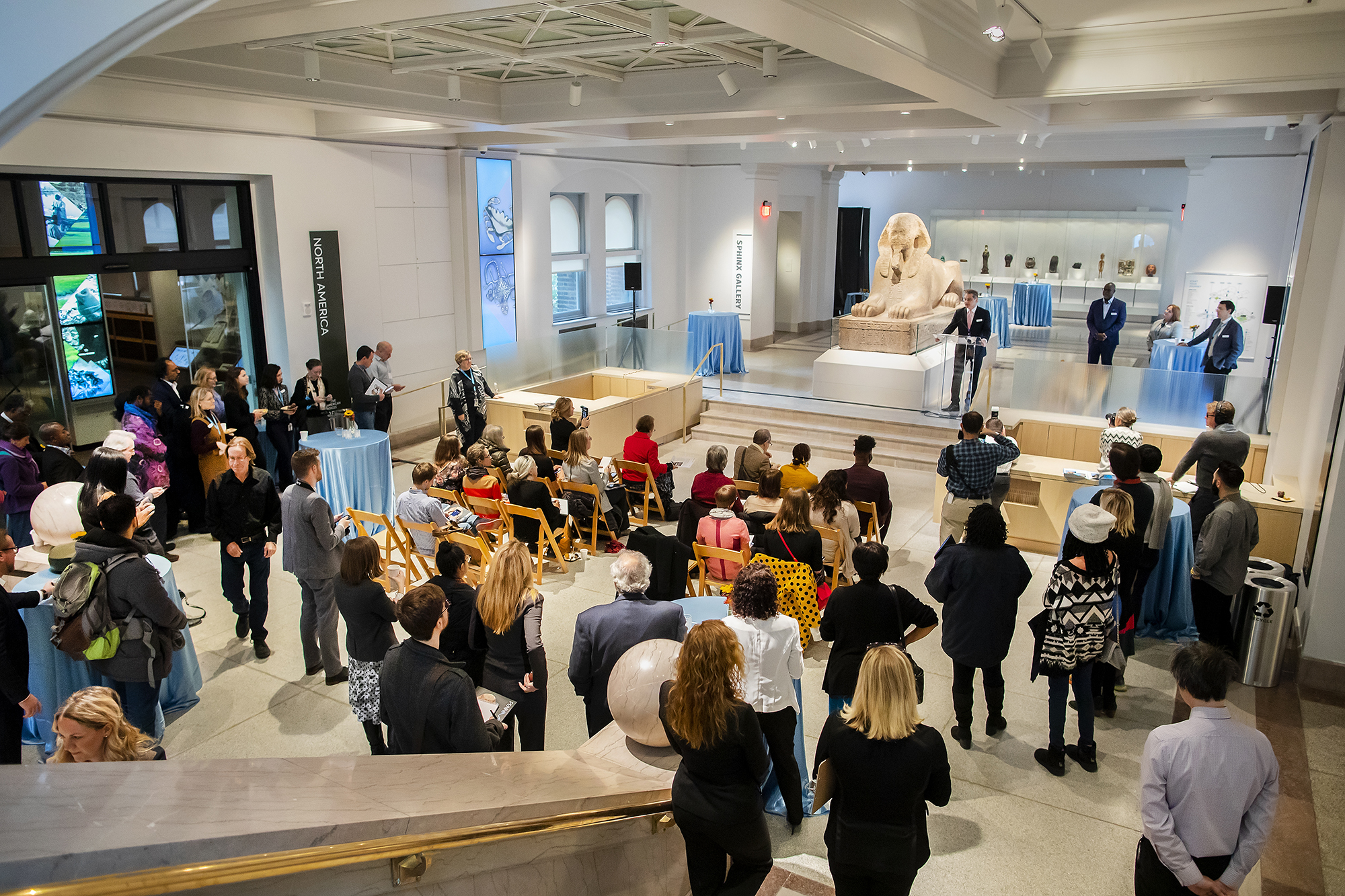
The Penn Museum’s beloved sphinx is front and center in the new main entrance, along with two other new galleries and a refurbished auditorium, the result of a yearslong transformative building renovation.
“This is a really wonderful moment for this Museum,” says Julian Siggers, Museum Williams Director.
“The Museum at its heart is about people, about their stories, their achievements, their ingenuity, their challenges, their triumphs,” Siggers said Thursday during a preview tour for the media. “This is one of the world’s great collections and tells our shared human story now being represented in new and compelling ways. Our galleries connect visitors with people of other times, places, and cultures.”
Along with the Main Entrance and Sphinx Gallery, the completely renovated Africa Galleries and Mexico/Central America Gallery feature familiar objects alongside hundreds of others that have never before been on display. Combined with the Middle East Galleries unveiled last year, and Native American Voices, all the exhibition space on the main floor has been updated.
In all, 10,000 square feet of space has been renovated in this phase of the transformation, at a cost of $33.5 million, including the sphinx relocation, according to the Museum.
“The public will come in and they will not only be able to see the cultures of the ancient world, but also see how they fit into it,” Siggers says. “This is very much a museum of who we are and how we got here.”
For the first time since the building opened in 1899, the entire level is air-conditioned, as is the completely refurbished Harrison Auditorium. New restrooms and elevators make the main floor fully accessible. Together the latest renovations will “radically transform how visitors will experience this museum,” Siggers says. “You won’t be able to recognize it from what it was before.”
The galleries are designed to the “highest international standards, and with many audiences in mind,” he says, including Penn students and faculty, but also the public, especially K-12 school children and families.
“We will always remain at our heart a teaching research museum, but [the renovation] was for the wider public in many ways,” Siggers says. “There are many levels to how the galleries speak to visitors. They are also highly interactive, which is how people actually expect to learn right now.”
An opening weekend celebration with myriad events will reveal the new spaces to the public, starting with a music and dance performance in the main entrance just before the official opening at 10 a.m. on Saturday, Nov. 16. Maya and Yoruban spiritual leaders will bless the new galleries to mark the ceremonial unveiling.
Penn students were treated to a preview during a party Wednesday evening. The previous weekend, Penn President Amy Gutmann spoke during a formal gala celebration, describing the Museum spaces as “lighter, brighter, and more open in every sense of the word.”
“The new Penn Museum is a treasure for our students, for the community, and for the world,” Gutmann said to the hundreds of guests gathered in the Sphinx Gallery. “Everyone who crosses our threshold gains insights into the past and how it informs our present, preparing us to lead a better future.”
Weeks earlier she signed one of the steel girders supporting the sphinx, her name joining others penned by those at the Museum for posterity, before being covered in finish casing. “That sphinx isn’t going anywhere for at least a hundred more years, I would predict,” Siggers says. “The names will be a big surprise for people who come after us.”
Main entrance: A grand welcome from a familiar face
Now centered in the spotlight, in an elevated gallery behind the main entrance desks, the 3,000-year-old red granite sphinx of Egyptian ruler Ramses II is the first artifact visitors encounter. The 12.5-ton sphinx, the largest in the Western Hemisphere and the fourth-largest outside of Egypt, was relocated there in June from the lower Egyptian Gallery, where it had been since 1926. It has not been on public display since June 2018.
“This is one of the most significant objects in the United States, and so to put him front and center seems to be exactly the right thing to do,” Siggers says. “We are thrilled this will be your entry experience to the Museum.”
Lined up behind the sphinx is a long glass case with 10 objects representing the Museum’s 10 sections, including a wood mask from Africa, a blue-green canopic jar from Egypt, a ceramic wine jug from the Mediterranean, and a stone effigy vessel shaped like a jaguar from South America.
An intimate adjoining gallery shaped like a cylinder features chosen artifacts that will change regularly; the first on display are two pairs of rare, well-worn Native American leather moccasins, one decorated with porcupine quills, made by hand 150 years ago. Curators will change the objects in that case about every six months.
Africa Galleries celebrate African art and culture and its place in the world
Spanning 4,000 square feet, the new Africa Galleries feature about 300 objects, more than half never before on display, chosen from the 20,000 objects in the Museum’s core African collection, one of the largest in the country.
Informing the redesign was data the Museum has been gathering for the past five years, asking visitors what they would like to see. The Africa Galleries are the most-requested for tours by K-12 school groups, Siggers says, and are important to Penn faculty and students, as well as the City of Philadelphia.
“It’s a great celebration of African art and culture and its place in the greater world,” Siggers says.
The reimagining of the Museum’s Africa Galleries has been a dream for lead curator Tukufu Zuberi, who has been at Penn for 30 years as a professor of Africana studies, race relations, and sociology.
“We redesigned the Africa Galleries to be in conversation with the now as well as the past, and to challenge the conceptualization of Africa. We want to decolonize the mind that looks at Africa in these galleries,” Zuberi says.
For the past two years he has worked to review the collection and conceptualize the galleries, consulting with a team of professors. The presentation is meant to show the breadth of the collection, with pieces from across the continent, in the context of their cultures, and in conversation with each other, he says. “We need to see in each piece: the designer, the maker, the user, and the place,” he says.
The main entrance with arched doorways evokes a palace, a bright blue wall covered floor to ceiling with geometric shapes in black steel by Brazilian artist Jorge dos Anjos. He also made a geometric steel sculpture of the god Exú, who is thought to guard gateways between worlds, featured in the wall, meant to welcome visitors and be in conversation with an iron sculpture of a protective figure made 100 years earlier by an unknown artist in Republic of the Congo. It is among three site-specific works created by contemporary African and African Diaspora artists strategically placed to interact with objects from the collection.
An interactive touchscreen presents an overview of the exhibition, named “From Maker to Museum.” Sections are focused on topics, including spirituality, kingdoms, design, ivory, currency and exchange, and instruments of both battle and music. Objects are displayed with their African name as well as the description in English, and many are accompanied by narratives to tell their stories, through text or touchscreens.
“We are saying that the presentation of this material culture is a statement as much about the collectors as it is about the items,” Zuberi says. “We are looking at the makers, the people who created these things, as well as the University, and why are these items here at this time, and why did we make the decisions we have made to put the specific items there in the exhibition.”
Most of the objects in the African collection were created in or taken out of Africa during periods of enslavement and colonization, and the new galleries include a critical look at the issues surrounding their acquisition. Many of the descriptions explain their journeys of being bought and sold.
As an example, Zuberi points to dozens of sacred objects in the exhibition that come from the Benin Royal Palace, seized by British soldiers during an 1897 invasion of the West African nation. The handwritten letter by the brother of a British army doctor offering items to the Penn Museum is on display, alongside those objects from the palace shrine, including an exquisitely carved ivory amulet.
“We want to have this discussion,” Zuberi says. “The provenance, the narrative of how this object got from there to here, is as important as the creativity itself.”
Mexico/Central America Gallery links ancient past with vibrant present
The Mexico/Central America Gallery showcases the great civilizations of the region spanning 3,000 years, including Olmec, Teotihuacan, Zapotec, Veracruz, Huastec, Aztec, and Maya. The exhibits feature development of complex writing, elaborate calendars, and even a ball game, along with stunning jewelry, sculptures, ceramics, and textiles.
“You're going to see some objects that you’ll find very difficult to see outside of Mesoamerica,” says Siggers.
The gallery’s black walls create a dramatic backdrop that accentuates the ceramic and stone artifacts and bright gold jewelry. The 2,000-square-foot gallery has about 200 objects, more than half on display for the first time. The earliest, from 1800 BCE, are figurines found buried beneath what is Mexico City today, and the most recent are Maya textiles from the late 1940s. The original gallery was commissioned in 1949 and last updated in any significant way 1954.
The American collection is the largest in the Museum’s collection, at more than 300,000 objects.
“We’re showing the best of what we previously had on display, but also excavating pieces from our storerooms,” says lead curator Simon Martin, Museum associate curator and keeper of the collection, and adjunct faculty in the Department of Anthropology. “There are very coherent stories that come out of the objects we have based on rulership, power, and religion.”
Unlike the collections from the Middle East and Africa, which came to the Museum through excavations and acquisitions more than 100 years ago, Penn’s expeditions in Mexico and Central America started in the 1930s, Martin says. “It was a time when we didn’t bring things back,” he says.
What the Museum didn’t have in its collection, it has borrowed to represent the major civilizations. New to the Museum are 36 objects on long-term loan from the Philadelphia Museum of Art’s pre-Columbian collection. Especially important are those from the Aztec culture, from 1350 to 1519, including monumental stone sculptures, some of which are from the sacred precinct at the heart of the Aztec Empire.
“They allow us to explain the bigger story,” Martin says. “The idea is to give a completely representative view of that part of the world.”
One of Martin’s favorite objects on loan is a “very remarkable and very rare” Water Goddess sculpture, one of only two in the world, dated to 100 CE, from Teotihuacan civilizations. A deity of fertility and abundance, it still has visible traces of red and green paint.
Most of the Museum’s permanent collection is from the Maya culture, Martin says. The star is a 9-foot-tall limestone monument, “Piedras Negras Stela 14,” from 758 CE carved with the image of a seated king wearing an elaborate headdress, his mother at the bottom of a ladder leading up to him. A Penn Museum archaeologist in the 1950s was the first to realize that Maya monuments and their inscriptions were historical. Stela 14 played an important part in that discovery.
It is one of several Maya stelas in the exhibition. On Stela 5 from Belize, a new feature allows visitors to press buttons to illuminate the faded carvings, bright white lights superimposed on the stone showing the images in great detail.
Another large object in the galleries is a facsimile of a facade from a buried temple in Honduras that Penn excavators discovered in 1992. It was laser-scanned, fabricated by a computer-controlled drill, and painted to the original’s specifications. “It is spectacular, and the future of archaeology, which is not bringing things back, but instead digitally sharing them,” Martin says. “The original lies 60 feet underground to this day.”
Maya culture is also known for writing in hieroglyphs, demonstrated by three other stone monuments in the exhibition. A touchscreen station allows visitors to learn about and digitally create their own hieroglyph name.
“Part of our mission is to show the ancient Maya and the Maya today, standing to represent all continuing cultures,” Martin says, who worked with Lucy Fowler Williams, the Museum’s Associate Curator and Keeper of American Collections, on the textiles and other modern aspects of the exhibition.
A new sound bench allows visitors to hear ancient languages still spoken in the region today. Videos show contemporary dance and weaving and explain the meaningful contexts of their continued expression.
“We are talking about the heritage of many modern North Americans,” Martin says. “This is a link between their cultures, particularly Spanish-speaking cultures, and their past.”
Harrison Auditorium renovated for the first time in nearly a century
Original staircases have been reopened to lead from the main entrance down to the Harrison Auditorium. One of the largest public venues on campus, the circular space has been completely refurbished, from restoration of the largest unsupported masonry dome in the United States to new floors and everything in between.
The 614 seats, dating to the 1940s, were removed, restored, and returned, resplendent in jade green velvet. The green tiles in the Art Deco architectural accents decorating the elaborate dome are visible again, the residue from years-ago cigarette smoke removed. The historic lamps are refurbished and supported with additional lights, and the stage updated, in the first full renovation since the auditorium opened in 1915.
“It's a great treasure on campus,” Siggers says, a “magnificent performance space” for the Museum and the Penn community. The Museum’s Great Lecture Series will be held in the auditorium, the first one on Dec. 4, The Destruction of Pompeii and its Aftermath.
What’s next
The new galleries are expected to boost attendance, which has been about 180,000 annually, or an average of 15,000 visitors a month, for the past few years. The Museum expects attendance to increase 60 percent in the next three to six months, and then settle in at about a 30-percent increase to 234,000 annually, or an average of 20,000 a month, thereafter.
There is even more to come as the building transformation continues, which, when completed, will renovate about 44,000 square feet of space in the building, including more than 75 percent of the public galleries. The Museum, founded in 1887, has a collection of more than 1 million objects.
Now under construction are the Ancient Egypt and Nubia Galleries, which will feature more than 3,000 items. The Museum’s collection of Egyptian artifacts is one of the largest in the country with about 50,000 objects, most of them discovered by Penn archeologists during expeditions in the late 19th century.
The focus of the Egyptian galleries will be the afterlife, with mummies and other objects from tombs. Plans also include a reconstructed pharaoh’s palace with 23-foot-high grand pillars. Opening is targeted for 2023, pending funding. Until then a temporary exhibition of more than 200 objects, “Ancient Egypt: From Discovery to Display,” are on exhibit on the third floor.
“It's absolutely thrilling. I mean, it has been one of the great privileges of my professional life to come and work on this project that will be so transformative to everything we do,” Siggers says of the building’s reconstruction.
“It’s been wonderful to watch these galleries unfold, because they are a master class in taking extremely complex ideas and making them very accessible,” Siggers says. “People can actually understand the work that we are doing here as well as the ancient cultures that we are presenting.”




